Trumpeter
1/72 Fairey Gannet AS.1/4
|
KIT #: |
1629 |
|
PRICE: |
$31.95 MSRP |
|
DECALS: |
Two options |
|
REVIEWER: |
Tom Cleaver |
|
NOTES: |
Used FAA Models Gannet sets FAAM001, FAAM002, FAAM003; Eduard
SS290 Gannet Interior; Xtradecal 72-070. Some original
Trumpeter kit remains. |
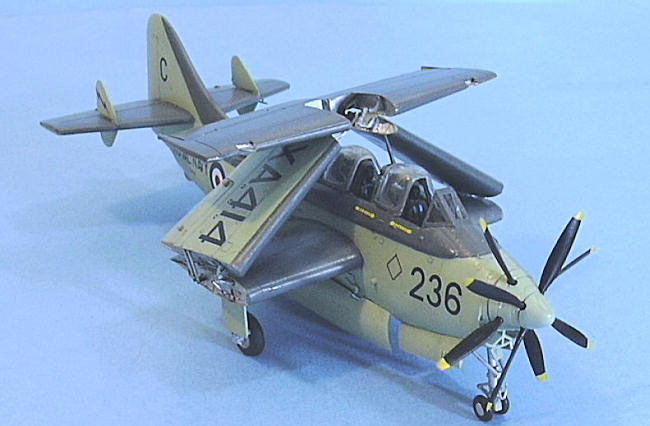
For the Fleet Air Arm, the
near-defeat of the Allied forces in the Battle of the Atlantic had taught the
lesson that there was a need for a carrier-based anti-submarine aircraft that
could be seen as a conceptual modernization of the Grumman Avenger, i.e., an
aircraft large enough to carry the gear necessary to detect a submarine, the
ordnance necessary to destroy the target, and the fuel to provide the range,
with enough speed to hit he target before it could submerge.
Fairey Aviation, as one of the main
providers of aircraft to the FAA, was already thinking of what could be called
an “Avenger replacement,” particularly since it was known that the rules of
Lend-Lease were such that the FAA would have to get rid of its fleet of Avengers
as rapidly as possible following the end of the war, thus creating an equipment
gap that could be usefully filled by a domestic design.
Several proposals were put forward, including one to
create a twin-engined version of the Firefly, in which the second engine would
be buried in the fuselage behind the pilot, with each engine driving one set of
blades of a contra-rotating propeller.
The Admiralty issued GR.17/45 in
late 1945. Looking at the specifications the design staff at Fairey decided one
of their other projects - originally an observation aircraft with twin Merlins -
could be developed into a suitable airframe
for carrying the new
 electronic equipment now available
and could be modified to use turboprops rather than reciprocating engines. While Fairey worked on what was now called the “Type Q,” Blackburn submitted the YB.1
design (also known as the B.54/B.88). With typically-British bureaucratic
decisiveness, approval was given in August 1946 for two prototypes to be built -
one from Blackburn and one from Fairey.
electronic equipment now available
and could be modified to use turboprops rather than reciprocating engines. While Fairey worked on what was now called the “Type Q,” Blackburn submitted the YB.1
design (also known as the B.54/B.88). With typically-British bureaucratic
decisiveness, approval was given in August 1946 for two prototypes to be built -
one from Blackburn and one from Fairey.
For a power plant, Fairey settled
early on the Armstrong-Siddeley Mamba turboprop, coupled with two independent
power sections driving separate propellers and known as the Double Mamba and
later known as the Twin Mamba.
While both sections were used for take-off, one could
then be shut down in flight, extending range and patrol time. The engine used
diesel fuel, which meant the airplane could use its aircraft carriers' diesel
fuel bunker and thus eliminating special aviation gas tanks aboard ship, which
greatly improved safety and vulnerability in combat.
Originally the design included a
two man crew, with the pilot seated well forward and given a good view over the
nose for carrier operations, and an aerial observer seated under a separate
canopy directly behind the pilot. After initial flight tests, a second observer
position was added, with a cockpit over the wing trailing edge. This created a
disturbed airflow over the horizontal stabilizer.
Small finlets were placed outboard on the stabilizers to
on either side to correct this. A large internal weapons bay was included, with
a retractable radome immediately aft of the bomb bay.
The constricted size of hangar decks on British carriers
necessitated a radical wing fold system to allow the airplane to be struck below
decks and carried aboard in sufficient numbers.
The result was a distinctive Z-shape for each wing. A
tricycle landing gear was used to make landings and takeoffs easier.
The prototype, known named “Gannet”
after the large sea bird found in the North Atlantic,
first flew on September 19, 1949 and made the first deck
landing by a turboprop aircraft on an aircraft carrier on June 19, 1959, when
LCDR Callingham landed aboard HMS Illustrious.
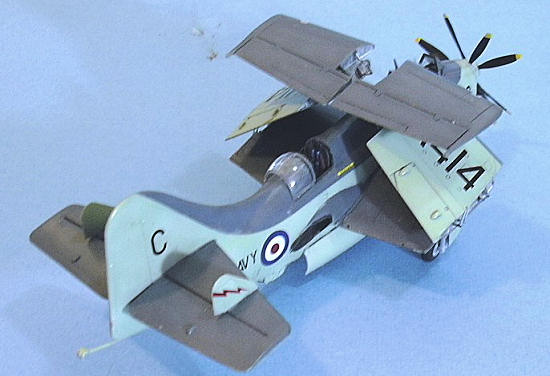 The Gannet entered production in
1953 with an order for 100 as the Gannet AS Mk.1.
The first aircraft were delivered to 826 Squadron at
RNAS Ford in April 1954, and after work-up, the squadron embarked on HMS Eagle.
In august 1954, the T. Mk.2 trainer first flew, followed by 35 trainers.
The Gannet entered production in
1953 with an order for 100 as the Gannet AS Mk.1.
The first aircraft were delivered to 826 Squadron at
RNAS Ford in April 1954, and after work-up, the squadron embarked on HMS Eagle.
In august 1954, the T. Mk.2 trainer first flew, followed by 35 trainers.
In 1956, the first of 255 up-rated
Gannet AS Mk.4 arrived in the FAA, which allowed for complete replacement of the
aging Fireflies and Avengers.
The first prototype of the Gannet
AEW Mk3 flew in 1958, filling the need for an airborne early warning aircraft to
replace the Douglas Skyraider AEW Mk.1. The Mk.3 involved a major re-design that
included a new fuselage and longer undercarriage to allow for a radome. 44 AEW 3
Gannets used the American radar that had equipped the Skyraiders; following the
retirement of these aircraft, their radars continued in use by the AEW
Shackletons.
By the middle of 1960, the AS.1 and
AS.4 Gannets were replaced by the Westland Whirlwind in FAA frontline ASW
service.
A few AS.4s were modified as the ECM.6 with major modifications and
additions to the electronics suite. These aircraft were only shore-based.
The COD.4 was modified from the AS.4 as a basic
transport after most internal equipment to create space for extra seats or
cargo.
The Royal Australian Navy purchased
36 Gannet AS.1 aircraft, which operated from the aircraft carrier HMAS
Melbourne and the shore base HMAS
Albatross near Nowra, New South Wales, and were
used until 1968. The German Navy bought 40 AS.4 and eight T.5s rebuilt from
T.2s, which were operated until the early 1970s. Indonesia bought a number of
AS.4s and T.5s that were rebuilt AS.1s and T.2s in 1959.
Several Gannets have survived in
museums, including two airworthy Gannets operated in the United States.
The first 1/72 plastic kit of the
Fairey Gannet was a very basic release from Frog which I first saw at the old
Bonnie Brae Hobbies in around 1959 if I recall correctly.
This was a very basic kit with the crew represented by
heads molded into the cockpits.
Having already fallen in love with Odd Brit Aeroplanes
after finding William Green’s and Gordon Swanborough’s “All The World’s Aircraft
1954" in the local library, I really liked these Frog kits that gave me the
ability to make models of those strange airplanes, including at least a couple
Gannets.
This kit was later updated somewhat, and was the basic Gannet kit for
the 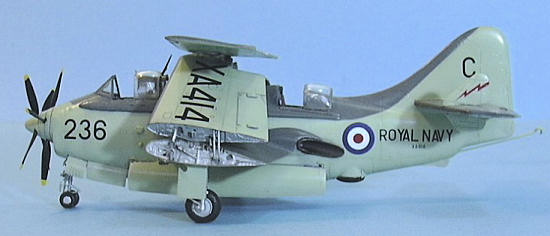 next 30-odd years.
In the 1990s, Dynavector released a very good 1/48
vacuform Gannet, and last year Classic Airframes released a limited-run
injection-molded 1/48 Gannet that is quite nice.
next 30-odd years.
In the 1990s, Dynavector released a very good 1/48
vacuform Gannet, and last year Classic Airframes released a limited-run
injection-molded 1/48 Gannet that is quite nice.
This 1/72 kit from Trumpeter,
released last fall, is the first new kit of the Gannet from a major manufacturer
since the Frog offering.
As of this month, there is now a second 1/72 kit from
Revell available.
Trumpeter’s kit provides 99 parts
and a decal sheet with three aircraft, one West German Navy and two Fleet Air
Arm.
The flaps are separate and can be posed open.
Several aftermarket items have been
produced for this kit, including three very good resin sets from FAA Models that
allow a modeler to create a Gannet with the bomb bay open and filled with
ordnance, and folded wings, which can be obtained from A2ZeeModels
(http://www.a2zeemodels.co.uk).
These resin parts are well designed and crisply molded.
Xtradecal 72-070 provides very good decals for six different airplanes.
Eduard has released two different photo-etch cockpits,
one for the AS.1 and one for the AS.4 that provides pre-painted detail much
better than most modelers can create in this small scale.
I decided to use everything in my
project.
Construction began with the
fuselage, as I cut off the molded-in bomb bay doors and then dremeled that area
smooth so that I could put the resin bomb bay in position.
Once the bomb bay was removed from its molding block and
cleaned up, it fit perfectly.
I attached the radome in the fully-retracted position.
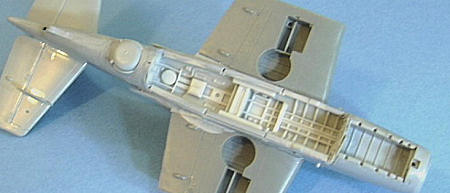 I painted the kit cockpit parts in
Tamiya “NATO Black” with the seats painted “Hull Red” to simulate the Bakelite
they were made from.
I attached the Eduard photo-etch parts as I assembled
each cockpit, and then glued them in position in the fuselage half.
I cut off the floor in the pilot’s cockpit forward of
the instrument panel to provide as much space as possible for what I knew was
going to be a maximum amount of weight to insure nose-sitting. I used small
fishweights, which I squeezed as thin as possible with pliers, and then stuffed
them into every nook and cranny in the nose.
When I glued the fuselage together, it was clear there
was sufficient weight in there.
I painted the kit cockpit parts in
Tamiya “NATO Black” with the seats painted “Hull Red” to simulate the Bakelite
they were made from.
I attached the Eduard photo-etch parts as I assembled
each cockpit, and then glued them in position in the fuselage half.
I cut off the floor in the pilot’s cockpit forward of
the instrument panel to provide as much space as possible for what I knew was
going to be a maximum amount of weight to insure nose-sitting. I used small
fishweights, which I squeezed as thin as possible with pliers, and then stuffed
them into every nook and cranny in the nose.
When I glued the fuselage together, it was clear there
was sufficient weight in there.
The kit wings are discarded for the
resin parts provided for folding the wings. There are three main parts for each
wing, with small detail parts for the wingfold areas.
I attached the inner wings, and then the horizontal
stabilizers and finlets.
At this point, the model was ready for paint.
Painting:
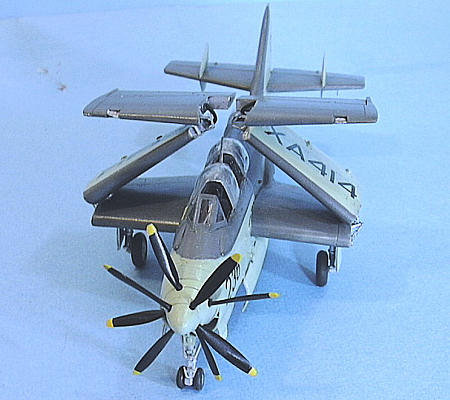 The wheel wells, bomb bay, landing
gear, interiors of gear doors and bomb bay doors, and the interior areas of the
folded wings, are painted aluminum.
I used Tamiya Flat Aluminum for this.
The exterior was painted with Xtracrylix “Extra Dark Sea
Grey” and “Sky.”
When all was dry, I gave the model a coat of Xtracrylix Gloss
varnish.
The wheel wells, bomb bay, landing
gear, interiors of gear doors and bomb bay doors, and the interior areas of the
folded wings, are painted aluminum.
I used Tamiya Flat Aluminum for this.
The exterior was painted with Xtracrylix “Extra Dark Sea
Grey” and “Sky.”
When all was dry, I gave the model a coat of Xtracrylix Gloss
varnish.
Decals:
I used Xtradecal 72-070 to do the
Gannet AS.Mk.4, XA414, of 810 Squadron aboard HMS Centaur
in 1960.
These are excellent decals and went on without difficulty.
When all was set, I washed the model and dried it, then
applied a coat of Xtracrylix Satin varnish.
I attached the landing gear, put
the torpedoes and flares into the bomb bay, and glued the bomb bay doors in the
open position.
The kit-supplied canopies can be posed in the open position,
which I did so the Eduard detail could be seen.
The folded wings are not as hard as
they appear, though they are certainly not easy and do require considerable
attention.
The big thing to be careful in
doing is to get the middle wing section in the correct position when attaching
it to the inner wing.
I studied several photos to get the position and angle
of the fold; in the end it turned out I had missed getting the accurate
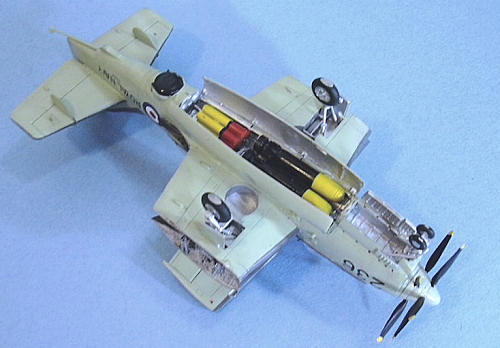 attachment point by about 1/32 inch or less, when I was unable to attach the
wing braces without them bowing.
At that point, I was unwilling to break what had been
fully assembled and to start over.
The braces are on the wing when the airplane is parked
and there are photos of it without the braces, so that is how this ended up.
attachment point by about 1/32 inch or less, when I was unable to attach the
wing braces without them bowing.
At that point, I was unwilling to break what had been
fully assembled and to start over.
The braces are on the wing when the airplane is parked
and there are photos of it without the braces, so that is how this ended up.
After assembling the inner and
central wing sections with cyanoacrylate glue, I attached the detail parts as
best I could after again studying the detail photos.
For me, I doubt this model will ever been seen by anyone
who is any sort of expert on the Gannet wingfold.
In other words, “close enough.”
The detail parts for the attachment of the outer section
were glued to that part and the central part, and then the outer wings were
carefully placed in position and made solid with cyanoacrylate. The ultimate
result is pretty strong, but also quite brittle, so it needs care in handling.
The Gannet is an odd-looking
airplane to begin with, and even odder with its wings folded, which makes it a
perfect choice for display at Le Chateau du Chat.
I believe all the parts used in this review can also be
used with the new Revell Gannet.
It’s definitely not a weekender, but it’s also
definitely a model that will get a universal second look when completed.
Thanks to Stevens
International for the review kit.
Thanks to A2Zee Models, Eduard and Hannant’s for the
aftermarket sets.
I know that Tom generally doesn't provide references, but Mushroom
Model Publications' new Gannet in RAN Service book would be superb for this as
would the equally good 4 Plus book. This is especially true if one wants to add
detail to any Gannet kit. Ed
Tom Cleaver
August 2008If you would like your product reviewed fairly and quickly, please
contact
me or see other details in the
Note to
Contributors.
Back to the Main Page
Back to the Review
Index Page2015


 electronic equipment now available
and could be modified to use turboprops rather than reciprocating engines. While Fairey worked on what was now called the “Type Q,” Blackburn submitted the YB.1
design (also known as the B.54/B.88). With typically-British bureaucratic
decisiveness, approval was given in August 1946 for two prototypes to be built -
one from Blackburn and one from Fairey.
electronic equipment now available
and could be modified to use turboprops rather than reciprocating engines. While Fairey worked on what was now called the “Type Q,” Blackburn submitted the YB.1
design (also known as the B.54/B.88). With typically-British bureaucratic
decisiveness, approval was given in August 1946 for two prototypes to be built -
one from Blackburn and one from Fairey.
 next 30-odd years.
In the 1990s, Dynavector released a very good 1/48
vacuform Gannet, and last year Classic Airframes released a limited-run
injection-molded 1/48 Gannet that is quite nice.
next 30-odd years.
In the 1990s, Dynavector released a very good 1/48
vacuform Gannet, and last year Classic Airframes released a limited-run
injection-molded 1/48 Gannet that is quite nice.

 attachment point by about 1/32 inch or less, when I was unable to attach the
wing braces without them bowing.
At that point, I was unwilling to break what had been
fully assembled and to start over.
The braces are on the wing when the airplane is parked
and there are photos of it without the braces, so that is how this ended up.
attachment point by about 1/32 inch or less, when I was unable to attach the
wing braces without them bowing.
At that point, I was unwilling to break what had been
fully assembled and to start over.
The braces are on the wing when the airplane is parked
and there are photos of it without the braces, so that is how this ended up.